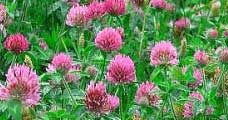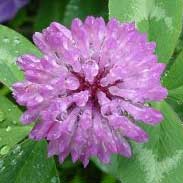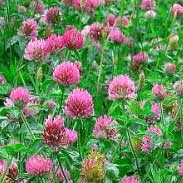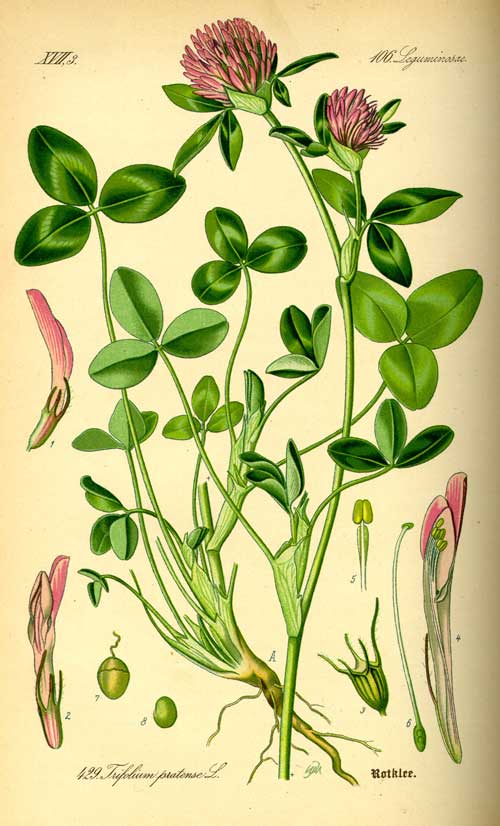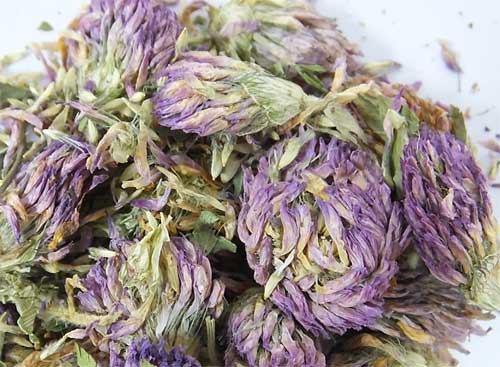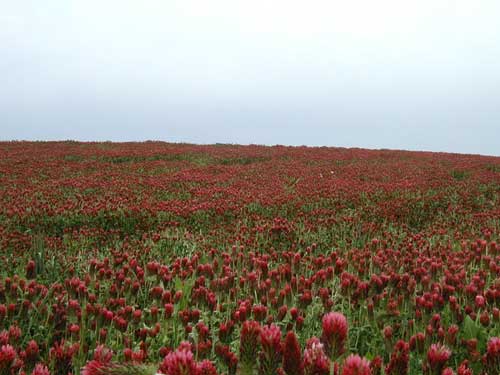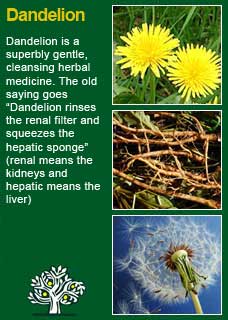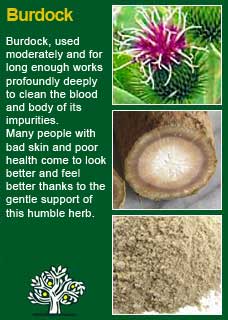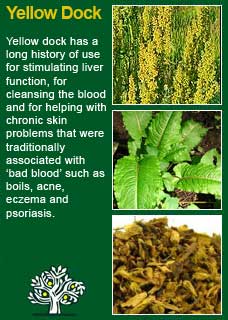
|
|
||||
| Our Pages ABOUT CONSTITUTIONAL MEDICINE
|
In herbal medicine we use the small but strikingly pretty flowers of Red Clover; a plant that grows freely around the world where there are green and grassy spaces.
Red Clover was highly regarded in the ancient world as a cleansing medicinal herb, especially when chronic disease had set into the lungs or the skin. Russian folk healers and traditional Chinese physicians have long used Red Clover for asthma, bronchitis and to clear the lungs. The treatment of cancer with Red Clover has a great many advocates and has been with us for a long time. Whilst there have been some very preliminary scientific studies to support the anti-cancer properties of Red Clover the evidence throughout the ages, like virtually all of our herbal lore, has been gathered through experience and observation. (I have included a particularly compelling story in this regard at the bottom of this page) From King's Dispensatory in1898; Red clover is an excellent alterative, and one of the few remedies which favourably influences pertussis. It is also a remedy in other spasmodic coughs, as those of measles, bronchitis, laryngitis, phthisis, etc. Finlay Ellingwood writes in the early 20th century, 'it (Red Clover) is given where a cancerous diathesis (tendency) is known to be present, and its use is persisted in for months. Improvement in objective phenomena is reported from a number of excellent observers. The agent is also prescribed in irritable conditions of the larynx and air passages, especially if evidenced by spasmodic cough. It has served a good purpose in whooping cough, in the cough of measles, and in general bronchial or pulmonary irritation. A dry, irritable cough will respond most readily to its influence' H Felter writes 'Trifolium is alterative and antispasmodic. It relieves irritability of the respiratory tract, alleviating dry, irritable and spasmodic cough. Whooping cough is especially moderated by it, and it is frequently effective in lessening the distressing cough of measles, though in both disorders it fails as often as it succeeds. It also modifies cough in bronchitis and laryngitis. Its alterative powers are underrated, and it should be given where a general deobstruent effect is desired in chronic skin diseases, and unquestionably has a retarding effect upon malignant neoplasms. Though by no means curative in carcinoma, patients who have been operated upon for cancer are slower in redeveloping the growths when given tincture of Trifolium daily' D Hoffmann writes 'Red Clover is a useful remedy for children with skin problems. It may be used with complete safety for any case of childhood eczema, and can be effective for other chronic skin conditions as well, such as psoriasis. An an alterative (blood cleansing herb) it is indicated as part of a holistic approach for a wide range of problems'' Hoffmann suggests doses of 2-4mls of the 1:5 tincture in 40% ethanol or a 10-15 minute infusion of 1-3 tsps of the dried herb. The British Herbal Pharmacopoeia (BHP) describes Red Clover's actions as mildly antispasmodic & expectorant and says it is indicated for chronic skin disease & whooping cough and specifically indicated for eczema & psoriasis. The BHP suggests a dose of 4 gms or by infusion and suggests a tincture dose of around 1-3mls. T Bartram writes that Red Clover was used by 'Hippocrates and physicians of the Ancient World' and he describes its actions as deobstruent, antispasmodic, alterative, sedative, expectorant, with affinity for throat and salivary glands. Anti-inflammatory. Reputed anti-neoplastic for reduction of tumours and hard swellings, especially of ovaries and breast. Has a long traditional reputation for cleansing the lymphatic vessels through which cancer is believed to spread'
~ During the 19th and early 20th century Red Clover was prominently used in patent medicines for cancer and skin diseases but in the later years its reputation was widely dismissed by the medical establishment as being only anecdotal and unsupported by scientific evidence. However when Dr Jonathan Hartwell in the Journal of Natural Products demonstrated that 33 different cultures around the world use Red Clover to treat cancer researchers from the American National Cancer Institute were persuaded to do some research and found no fewer than four anti-tumour compounds within Red Clover including daidzein and genistein and the isoflavone biochanin A. ~ The authors, titles and the 'where-and-when' published of nearly 200 further studies and articles on Red Clover are listed in a PDF found here
I understand that the 'phyto-oestrogenic' effects of Red Clover are extremely mild and that consequently its ability to benefit menopausal symptoms, or bone loss etc. must not be over-estimated, they are likely to be moderate at best, however there should be a caution about using it in any significant amounts whilst pregnant. The other time I would be cautious about using is for a person who is taking blood-thinning drugs, as it may make the blood too thin. However, if there are good reasons to use it, then surely it makes more sense to have an open mind to potentially reducing the drug side of the equation rather than avoiding a herb like Red Clover that may make the blood less sticky and certainly will help it be to be more clean. Unlike a drug that carries real risks of toxicity along with making the blood too thin, such herbs are nearly always widely beneficial to the system as a whole, e.g. herbs/foods such as Garlic, Ginger etc. do not do harm by their frequent or generous intake, neither will Red Clover ever make the blood too thin by itself.
For some years now, against this proven and safe way of herbalism, there has been a rising tide of excessive caution and scare-mongering in many parts of the world. The same authorities that, not so long ago, decried herbal medicines as ineffectual, have now taken up a different adversarial position; that they are dangerous substances that should only be prescribed by Doctors, who of course have zero training in them. Unfortunately, the same unnecessary fear and worry has crept into many natural health websites and popular publications on herbs. Herbs that we have safely used for thousands of years, that have no reports of adverse reactions in the medical literature despite widespread use by millions of people, are suddenly described as contraindicated because of something that should have been seen as completely unimportant, or at the utmost a merely theoretical concern, such as a laboratory study on one of the herb's constituents to use an all too common example. I wonder sometimes if the writers of such articles feel that the herb will be more deserving of respect if it is thought to be a little bit dangerous, in other words more like a drug than something that has simply come out of the earth and been used by ordinary people for generations beyond count. There is just so much misinformation about herbal medicine on the internet now. Ludicrous claims and cautions abound in equal measure; it seems like one group are trying to make money out of the public whilst the other are busily trying to scare them off. I have to believe that the kind of reader who takes the time to read pages on herbs that are as extensive as this one is much less likely to be swayed by marketers or misinformers. I hope that you will keep your wits about you if you get conflicting opinions from people who have never really got to know these herbs, who have never worked with them, or learned how to use them safely and effectively. I want to remind you that the reason that herbs can never be patented and owned by any individual or corporation is because they are, and always will be, the People's medicine. They belong to all of us and it is my great hope in sharing this work that you will learn how to use them wisely for yourself, and the people you care for. Be safe, but do not be afraid.
I find Red Clover to be a gentle herb but at the same time to have remarkably penetrating properties. Red Clover brings a healing influence into hard to reach places and I have seen it greatly help health problems that have become stuck such as chronic lung or skin diseases. I will often think of using Red Clover when I see a person that has bad skin, a heavy coating on the back of their tongue and debris in their blood (from microscopic analysis). If used patiently Red Clover can be an extraordinarily deep cleansing herb and I personally think that it is this purifying property to the blood and lymph that has seen it gather such a potent reputation. Dosage is half the art of herbal medicine, and this is not a herb you have to be shy with! Smaller amounts may be perfectly adequate but, if needed, I would freely use up to 5mls a day of the tincture (in divided doses) or up to 4 grams a day of the dried herb combined into a formula where we want an immediate and strong effect from the herb. The flower heads are ideal and always to be preferred, but use the cut tops which include both flower and the upper leaves if that is all that is available to you. Note that a full, heaped tsp of Red Clover flowers is only about half a gram, being so light it is a bulky herb to use in quantity in the tea form. Consider using a tablespoon for preparation! If you who are reading this are studying herbal medicine or if you have your own reasons for needing to understand this plant ally at a much deeper level then I urge you to take a good dose of the tincture or the tea and then, with a quiet and attentive mind, observe closely how it makes you feel. This ancient method of 'experiential learning' can do more to help you appreciate the 'action' of the herb than any amount of academic study. Red Clover is as subtle as it is deep. Its rich colours, flavour and scent will be obvious but allow yourself a few minutes to let it penetrate into your blood-stream. It is a remarkably potent and 'whole-body' medicine that deserves the respect this kind of experience can give you along with, I hope, a personal understanding of why we have used such a common flower of the field as a front-line remedy against some of the hardest health problems we ever come against. Further to this, if you would like to learn more about the ancient art of pulse testing, a simple but powerful way to ask the intuitive intelligence of the body for its responses to a herb by feeling the pulse whilst giving a tiny dose by mouth, read here When it comes to deep blood and body cleansing Red Clover often combines perfectly with Dandelion root, Burdock root and Yellow Dock. There is also something about using the Red Clover flowers with these potent root medicines that softens their impact and makes the treatment more tolerable to those who might otherwise have something of a healing crisis when the cleansing process gets properly underway.
The following letter was written by Truman Woodford of West Hartford, Conneticut. It was re-published in the New York Evening Post and originally printed in the Phrenological Journal of December 1867. When about fifty years of age there appeared near the outer corner of my left eye a small scab, which slowly enlarged and soon became painful, attended with a constant itching, or rather a twitching sensation. Feeling anxious about it I applied to a physician in Hartford who said it was a cancerous affection but advised me to let it alone and give it no medical treatment. As the affected place continued to enlarge and the irritation increased I applied to another physician who attempted to cure it by applying caustic, which treatment proved an injury instead of a benefit.
Much of the information here about the traditional uses of Red Clover is consistent with the model of thinking whereby one may treat problem A with plant B. There is value in this approach, especially in how it helps us pass on useful knowledge to one another, but it falls short in one vital area; and that is that people are not all cut from the same cloth! Something that works brilliantly for one person may do less for another -- why is this? Part of the reason is that people vary in their constitutions as to whether they are either hotter or cooler and, at the same time, either dryer or damper. This useful and rather fascinating subject is introduced further here Another big part of using the right herb when it is most needed comes from understanding the need to treat what is going wrong for the person that had led up to their getting a health condition and in this light Red Clover can particularly offer its benefits when a cleansing action is needed in the innate 'cycle of healing', more about this here
Please understand that I cannot advise you, including on products or dosage, without seeing you in person in my clinic but for ideas
on how you might find a good herbalist in your area read here |
|
|
|
© 2011 R.J.Whelan Ltd
